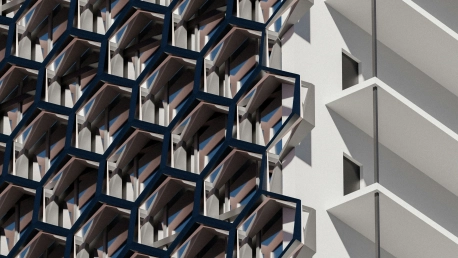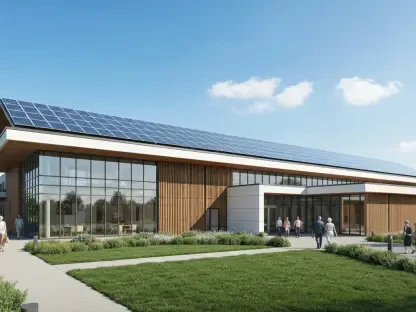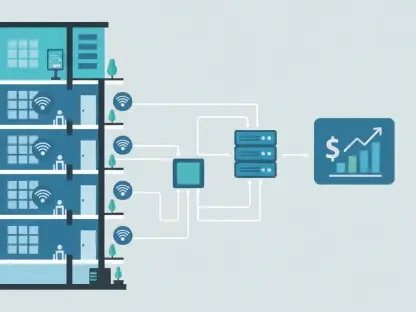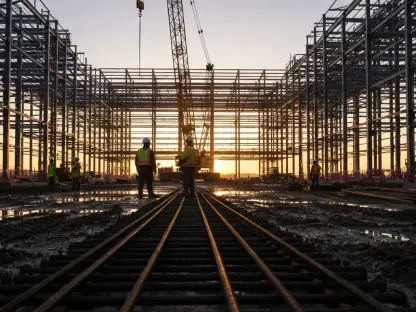3D rendering is a groundbreaking tool that translates intricate 3D models into stunning 2D images, blurring the line between virtual designs and real-world views. This innovative process not only enhances visual communication but also allows designers and consumers to experience a near-tangible perception of projects before they are physically realized. Its significance stretches across various sectors, from architecture to entertainment, pioneering new horizons in digital production.As 3D rendering evolves, it paves the way for creators and audiences to engage with digital content on a level that rivals actual experience. The technique’s growing realism continues to push the boundaries of how we interact with and visualize future creations. The prospects of 3D rendering are vast, hinting at a future where the digital and physical realms coalesce seamlessly, offering unparalleled visual storytelling and design validation tools. This digital alchemy of rendering not only captivates the imagination but also consolidates the relationship between conceptual ideas and their eventual manifestation in the physical world.
The Evolution of 3D Rendering
From Simple Models to Photorealism
In the early stages of 3D rendering, digital models were quite basic, consisting of wireframes that established the structural basis for more complex visualizations. These foundational models were pivotal in the progression towards highly realistic visual simulations. As the field advanced, groundbreaking strides were made through enhanced techniques in texturing. These methods, particularly texture and bump mapping, infused digital surfaces with a level of detail and realism previously unattainable. The result was imagery that closely resembled actual materials and objects, marking a significant milestone in the journey toward achieving lifelike digital representations. This leap in technology has not only improved visual aesthetics but also expanded the potential applications of 3D rendering across various industries.
Breakthroughs in Lighting and Materials
The quest for photorealism in computer graphics has driven the development and implementation of advanced rendering algorithms, most notably ray tracing and global illumination. These algorithms emulate the way light behaves in the real world with remarkable precision, allowing the creation of incredibly lifelike images. The intricacies of lighting, such as the way it bounces off surfaces and the subtle gradations of shadow and light, can now be captured with a level of detail once deemed unattainable.The progress in rendering technology has, in turn, brought hardware capabilities into sharp focus. Modern GPUs, with their robust processing power, have been pivotal in advancing the field. They efficiently handle the complex calculations required by sophisticated algorithms, thus accelerating the rendering process considerably. This has been a boon for artists and graphics professionals, who can now incorporate fine details and textural elements into their work with less concern about computational bottlenecks.Such advancements signify a transformative era in digital visual arts, where the boundaries between the virtual and the real increasingly blur. As the technology continually evolves, we can expect renderings to become indistinguishable from photographs, creating immersive experiences previously limited only by the imagination.
Technical Insights into 3D Rendering Processes
Core Rendering Algorithms
Ray tracing is an advanced rendering technique that closely simulates the behavior of light, bringing a lifelike quality to rendered images with its detailed portrayal of shadows, reflections, and transparency. By meticulously calculating the paths of light rays as they interact with objects in a scene, it offers a level of realism that can be virtually indistinguishable from reality.This contrasts with rasterization, which is more commonly employed in real-time applications such as video games. Rasterization is designed to be much faster but at the expense of some photorealism. It translates three-dimensional objects into 2D images rapidly, prioritizing speed to ensure gameplay remains fluid. The artistry in rasterization lies in its ability to provide a visually appealing experience without the computational intensity of ray tracing.While ray tracing is often associated with static images or sequences that can afford longer render times — such as in motion pictures or architectural visuals — rasterization continues to reign in situations where rendering must be instantaneous. However, advancements in computing power are increasingly bringing real-time ray tracing to the forefront of gaming and interactive media, promising a future where deeply immersive graphical realism is routine. Balancing the demand for both realism and responsiveness, developers and artists continue to push the boundaries of what’s possible in digital imagery.
Software and Hardware Essentials
In the dynamic realm of 3D rendering, a suite of robust software solutions stands out, including the likes of Blender, Autodesk 3ds Max, and Maya. These platforms are fundamental for crafting intricate models, breathing life into animations, and bringing visualizations to their final form. On the forefront of enhancing these software capabilities are GPUs, which have become the backbone of rendering efficacy.Modern GPUs have revolutionized the rendering landscape by dramatically slashing the time it takes to render complex scenes. Their advanced architecture facilitates rendering processes that were once unthinkable, allowing for higher levels of detail and realism. The intricacies of textures, lighting, and shadows that these GPUs manage translate directly into the quality and fidelity of the final image.This symbiosis between advanced software and high-performance GPUs has enabled artists and engineers to achieve stunning visual results. Whether for animation, architectural visualization, or VFX in film, the combination of powerful software and cutting-edge GPUs ensures that the most intricate designs come to life with exceptional clarity and depth. As technology marches forward, the partnership between these tools will continue to propel the standards of 3D rendering to new heights.
Optimization Techniques in 3D Rendering
Achieving a Balance Between Fidelity and Performance
In 3D rendering, achieving the perfect balance between high-quality visuals and efficient performance is essential. To maintain this balance, various strategies are put into place. One such strategy is using Level of Detail (LOD), which adjusts the complexity of 3D models based on their distance from the camera. This means that objects farther away are rendered with fewer details, saving valuable processing power.Another key technique is texture baking. This involves pre-calculating lighting and shading and baking it into textures so that during real-time rendering, the illusion of complex lighting is achieved without the heavy computational load.Efficiency is further boosted by occlusion culling. This process ensures that any object not in the camera’s line of sight is not rendered. Since hidden objects do not contribute to the scene as viewed by the audience, occlusion culling ensures that the computer’s processing capabilities are not wasted on them.These techniques collectively contribute to a more optimized rendering process, ensuring that the final output is visually impressive without putting unnecessary strain on the available computational resources. This thoughtful approach to rendering allows for the creation of lush, intricate virtual scenes that can run smoothly on a variety of devices and platforms.
The Artistic Touch in Rendering
In the world of digital artistry, the technical prowess of rendering is just the foundation. The true magic happens when an artist’s touch interweaves with the pixels and code, transforming basic digital canvases into emotive masterpieces. Adhering to core design principles, artists craft visually stunning and emotionally compelling scenes that captivate audiences.While the algorithms and software provide essential tools, it is the creative interpretation and subtle nuances introduced by the artist that infuse a render with life-like qualities. These nuances are crucial; they are what enable the digital scene to tell a story, to radiate an aura that pulls viewers into its unique world. The artist’s role is to meticulously mold this technical base into a work that not only showcases technical skill but also exudes an atmosphere that engenders an emotive response.The dance between technicality and artistry is delicate, each relying on the other to create something that is greater than the sum of its parts. The renderer’s meticulous adjustments, color grading, lighting finesse, and compositional balance all contribute to the final outcome—a render that does more than display imagery; instead, it conveys essence and emotion, making the inanimate profoundly alive. This is the beauty and challenge of digital rendering: to transcend the cold precision of technology by injecting personal vision and artistic breath, thus taking viewers on an unforgettable visual journey.
Real-World Applications of 3D Rendering
Transforming Architecture and Design
In the field of architecture, the evolution of 3D rendering technology has revolutionized the way designs are visualized and refined. Today, it’s not just a luxury but a necessity for architects and designers seeking to effectively communicate their concepts. These virtual models serve as prototypes, offering a clear and interactive representation of how a building would look and function once constructed.One of the most significant advancements in this area is the integration of photogrammetry in 3D renders. This technique merges accurate real-world data into the visualizations, delivering a comprehensive perspective of how a structure will blend with its surroundings. It is a step beyond mere imagination, enabling clients and stakeholders to experience the feel of the architecture within its true environmental context before the commencement of actual construction.This synergy of 3D rendering and photogrammetry elevates the level of precision and realism in architectural presentations. It facilitates better decision-making and design adjustments at early stages, significantly reducing the risk of costly modifications during the build phase. With this powerful tool, architects can ensure that their projects are not just theoretically sound, but also practically viable and harmonious with their intended location.
Enhancing Entertainment and Interactive Media
The capabilities of 3D rendering have revolutionized the entertainment sector, particularly in gaming and film. In the gaming realm, these advanced rendering techniques enable the creation of deeply engaging worlds that blur the line between digital and reality, providing players with an unparalleled sense of immersion. Game developers employ state-of-the-art technology to produce environments and characters that are incredibly detailed and lifelike, elevating the gaming experience to new heights.In the film industry, the impact of 3D rendering is equally significant. Visual effects teams integrate computer-generated imagery with live-action sequences to fabricate scenes that might otherwise be impossible to achieve through traditional filmmaking methods. This seamless blend of rendered visuals with actual footage allows filmmakers to bring fantastical elements into their narratives while maintaining a believable, tangible quality. From explosive action sequences to the creation of mythical creatures, 3D rendering has become an indispensable tool for modern storytelling in cinema.The fusion of these technologies into entertainment not only captivates audiences but also continually expands the horizons of what can be visually and narratively achieved. As 3D rendering technology advances, we can expect even more sophisticated and realistic content, further blurring the lines between fantasy and reality in the worlds of gaming and film.
Virtual Reality and Beyond
In Virtual Reality (VR), high-quality 3D rendering is crucial to creating a believable and engaging user experience. The rendering process not only focuses on the graphical quality but also on how the virtual world responds to the user’s actions, which is crucial for delivering a seamless interactive experience. This high level of immersion blurs the line between the virtual and the real, making experiences genuinely lifelike.VR’s potential extends far beyond gaming and entertainment. Its capability for crafting detailed, interactive virtual spaces holds the promise of transforming industries like education and healthcare. Through VR, students can learn through immersive simulations, making complex or abstract concepts easier to understand. Educators can leverage VR to transport students to historical sites or into the human body, providing a level of detail and interactivity that textbooks cannot match.Healthcare professionals can also benefit from VR’s advancements. By engaging in simulations, medical professionals can practice and perfect surgical procedures without any risk to patients. This safe, controlled environment is invaluable for training and improving the skills necessary for high-stakes operations.As VR technology continues to advance, its 3D rendering capabilities will only sharpen, further enriching user experiences across various fields. The fusion of realistic graphics and responsive environments in VR is set to redefine how we learn, train, and even entertain ourselves.
The Future of 3D Rendering
As we peer into the horizon of technological advancement, the fusion of artificial intelligence (AI) and machine learning (ML) with 3D rendering is poised to usher in a transformative age for the industry. This synergy promises to elevate the automation of rendering optimization, thereby streamlining efficiency and enriching the creative process. Additionally, the emergence of cloud rendering platforms is a game-changer, democratizing access to premium rendering tools. Such platforms empower a diverse range of creators, regardless of their hardware capabilities or location, by offering top-tier rendering services over the internet. This innovation not only levels the playing field for individual artists and smaller studios but also fosters more fluid collaborative endeavors across the globe. As these technologies continue to evolve, we can anticipate breakthroughs in both the speed and quality of rendered content, driving forward the realms of animation, visual effects, and design to previously unattainable heights.The quest for hyper-realism continues to revolutionize 3D rendering technology, but it is not the only driver of change. As computational demands increase, the significance of efficiency can’t be understated. Innovators are tackling this dual challenge: enhancing the visual experience and refining the rendering workflow to be more effective.A major factor now at play is the environmental impact of digital rendering. The industry is becoming more conscious of its carbon footprint, given the energy-intensive nature of current technologies. As rendering becomes more advanced, the push for sustainable practices is expected to intensify.Emerging trends indicate that the future of 3D rendering lies not just in achieving greater levels of detail and immersion but also in ensuring that these advances are achieved responsibly. Researchers are exploring ways to reduce power consumption and improve the energy efficiency of rendering hardware and software.Blending this eco-conscious approach with the push for richer graphics will likely lead to smarter rendering methods. These will combine cutting-edge technology with optimization techniques to trim resource usage without compromising quality. In essence, the industry is poised to evolve in a manner that delivers striking visuals hand in hand with ecological consideration, ensuring a balance between innovation and environmental stewardship.
Industry Impact and Future Prospects
Blurring the Lines Between Digital and Physical
As 3D rendering technology evolves, the distinction between virtual environments and real-world settings becomes ever more subtle. In the not-too-distant future, we can anticipate a seamless blend of digital and physical worlds, fundamentally changing the interaction dynamics within virtual spaces. This integration promises to elevate our experience with digital media to unprecedented levels.We’re on the cusp of an era where digital creations are not just enhancements to our reality but integral parts of our daily lives. High-fidelity simulations, once distinguishable from the material world, are now converging with it. This union is poised to revolutionize our engagement with the digital realm, influencing entertainment, education, and even the way we work.Our perception of what virtual spaces are capable of will be dramatically redefined as they become more ingrained in our daily routines. As this technology advances, it promises to offer an immersive experience that blurs the line between the digital and the physical. The implications of such a paradigm shift are profound, as this merger has the potential to transform how we perceive, interact with, and even define the “real” world.The limitless potential of 3D rendering is revolutionizing a spectrum of industries, as its applications continue to grow in unexpected ways. With each advancement in rendering technology, the door opens to novel applications that may revolutionize not just entertainment and design, but myriad other fields as well. Looking into the future, 3D rendering technology is not just an emerging player but a transformative heavyweight, shaping the way we engage with digital tools and environments.As the sophistication of 3D rendering improves, it could offer more realistic simulations in fields such as medicine, where it can be used for detailed visualizations of human anatomy, or urban planning, where it can predict the impact of architectural projects on cityscapes and the environment. The real estate market benefits from virtual tours of properties, giving potential buyers a lifelike view without physical presence.Even more, with the integration of AI and machine learning, 3D rendering is on the cusp of self-improving visuals that could outpace manual design processes. In education, immersive 3D environments foster interactive learning experiences, making subjects like history and science more engaging. Retail is another sector that is transforming; virtual stores could soon redefine the shopping experience.As we advance, expect to see 3D rendering become even more pivotal. From hyper-realistic video games to virtual reality experiences that defy our senses, the impact is clear: 3D rendering is actively carving the future of technological interaction and application across the global stage.









